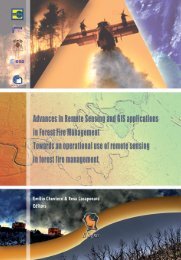EARSeL Newsletter - EARSeL, European Association of Remote ...
EARSeL Newsletter - EARSeL, European Association of Remote ...
EARSeL Newsletter - EARSeL, European Association of Remote ...
Create successful ePaper yourself
Turn your PDF publications into a flip-book with our unique Google optimized e-Paper software.
<strong>EARSeL</strong> <strong>Newsletter</strong> September 2002 - Number 51<br />
16<br />
4.2 Observations<br />
Boudewijn van Leeuwen (leeuwen@itc.nl),<br />
ITC, The Netherlands<br />
Recent Launches:<br />
Haiyang and Fengyun-1D<br />
On 15 May 2002, a Long March 4 rocket<br />
launched two Chinese satellites from<br />
Taiyuan, China. The Fengyun-1D satellite<br />
is a meteorological polar-orbiting platform,<br />
which is also designed to monitor flooding<br />
and other environmental phenomena. It is<br />
the sixth satellite in the Fengyun series.<br />
Haiyang-1 ("Haiyang" is Chinese for<br />
"ocean") is a marine observation satellite<br />
monitoring the Earth from a sun-synchronous<br />
orbit with a ten-band infrared ocean<br />
colour scanner and a four-band CCD camera.<br />
The first images from Haiyang-1 were<br />
received on 29 May 2002.<br />
Ofeq-5<br />
On 28 May 2002, Ofeq-5, the latest Israeli<br />
satellite in the Ofeq series, was launched by<br />
an IAI/MLM Shavit satellite launcher,<br />
from Palmachim missile test centre on the<br />
Israeli Mediterranean coast. The spy satellite<br />
acquires very high resolution multispectral<br />
images from a retrograde polar<br />
orbit <strong>of</strong> about 450 kilometres. (See web-site<br />
www.iai.co.il/iai/dows/Serve/level/english/1.1.htm).<br />
NOAA-M<br />
On 24 June 2002, a Titan 2 successfully<br />
launched NOAA’s latest bird, NOAA-M,<br />
into a polar orbit. One day later the first<br />
image was received from the satellite. On<br />
14 July 2002, after the on-orbit verification,<br />
NASA turned over operational control to<br />
NOAA and the satellite was renamed<br />
NOAA-17. NOAA-17 is the third polar-orbiting<br />
satellite currently in operation. Like<br />
the earlier NOAA satellites, its instruments<br />
will collect meteorological data and other<br />
environmental data. Currently the first<br />
data is being released by NOAA. (See website<br />
www.noaa.gov).<br />
Cosmos-2392<br />
On July 25 2002, a Proton K/DM-2M<br />
launch vehicle launched the Cosmos-2392<br />
from Baykonur, Kazachstan. Apart from<br />
performing reconnaissance activities, the<br />
military satellite will provide data for environmental<br />
monitoring <strong>of</strong> the Earth in the<br />
framework <strong>of</strong> the civil space programme.<br />
MSG-1<br />
On 28 August 2002, after a 24-hour delay<br />
due to communication problems between<br />
the control centre and the launch vehicle,<br />
two satellites were successfully launched by<br />
an Ariane 5 from Guiana Space Centre at<br />
Kourou, French Guiana. Both the Atlantic<br />
Bird 1 (a communication satellite) and the<br />
MSG-1 (Meteosat Second Generation) were<br />
placed in a ge-ostationary orbit. With its<br />
twelve-channel SEVIRI instrument, MSG-1<br />
will improve weather forecasting and climate<br />
research. The additional GERB instrument<br />
is a broadband radiometer to measure<br />
the Earth radiation budget. About a year<br />
after launch, MSG-1 will commence operational<br />
service above the equator, at 0° longitude,<br />
taking over from Meteosat-7 as the<br />
main weather- and climate-monitoring<br />
satellite. MSG-1 is the first <strong>of</strong> three modern<br />
weather satellites in the Meteosat Second<br />
Generation programme. MSG-2 will be<br />
launched about eighteen months later, and<br />
MSG-3 will be built and put in storage until<br />
it is required to take over as MSG-1 nears<br />
the end <strong>of</strong> its life. (See web-sites<br />
www.esa.int/export/esaMI/MSG/index.ht<br />
ml and www.eumetsat.de).<br />
METSAT<br />
On September 12 2002, the Indian Space<br />
Research Organisation launched the<br />
weather satellite METSAT. The Polar Satellite<br />
Launch Vehicle, PSLV-C4 successfully<br />
brought the satellite into a geo-synchronous<br />
transfer orbit. From there the satellite<br />
will be raised to a 74 East geo-stationary<br />
orbit. This is India’s first satellite specifically<br />
dedicated to meteorology. Until now, the<br />
INSAT communication satellites were used<br />
as a platform for weather-monitoring instruments.<br />
(See web-sites www.isro.org).<br />
New data products available:<br />
SPOT 5<br />
SPOT 5 was launched on 3 May 2002, with<br />
the first images taken by the on-board<br />
High Resolution Geometric instruments<br />
being obtained on 7 May. On 12 July 2002,<br />
the French space agency CNES handed<br />
over responsibility for commercial opera-
















